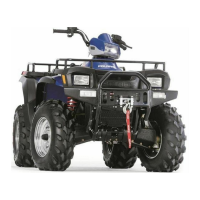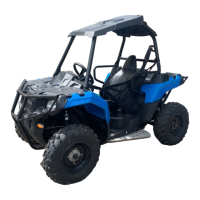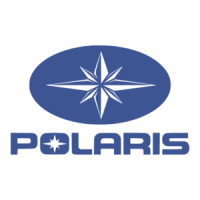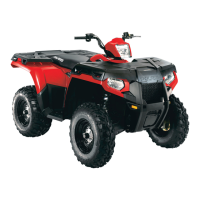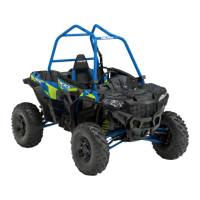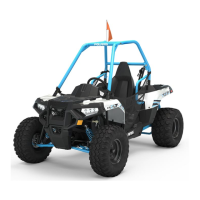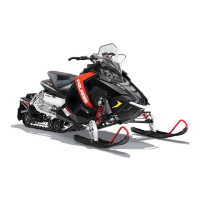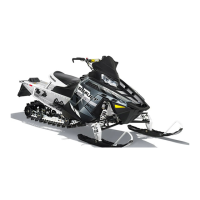ENGINE
3.11
OIL PRESSURE TEST -
EH50PL
1. Remove blind plug on front left cylinder head.
2. Insert a 1/8 NPT oil pressure gauge adaptor into
the cylinder head and attach the gauge.
3. Start engine and allow it to reach operating
temperature, monitoring gauge indicator.
NOTE: Use Polaris Premium 4 Synthetic Engine
Lubricant (PN 2871281).
Oil Pressure at 5500 RPM (Engine Hot):
Standard: 20 PSI
Minimum: 12 PSI
OIL PUMP PRIMING
PROCEDURE
NOTE: This priming procedure must be
performed whenever the oil hose connection
between the oil tank and pump inlet has been
disconnected.
Slit
Oil Tank
ent Hose
To Air Box
Pinch Off
2I
Approx.
1. Clamp or pinch off vent line approximately 2I
fromoiltanktoavoidtheendofoiltankventfitting,
and the vent line’s pressure relief slit
2. Run engine for 10--20 seconds.
3. Shut engine off. Remove the vent line clamp. A
rushofairshouldbeheard,indicatingtheoilpump
is properly primed and ready for field operation.
Note: Ifthesystem is primedproperlyyoushould
hear some air release. If you do not, the system
has not primed. Repeat theprocess if necessary.
OIL FLOW -- EH 50PL
The chart on Page 3.12 describes the flow of oil
throughtheEH50PLengine. Beginningattheoiltank,
the oil flows through a screen fitting in the bottom of
the tank and into the oil supply hose. The feed side
oftheoilpumpdrawsoilthroughthehoseand intothe
crankcase oil gallery, and then pumps the oil through
another passage to the one way valve. (When the
engine is off, the one way valve closes to prevent oil
in the tank from draining into the crankcase.) The oil
ispumpedthroughadeliverypipe totheoilfilter. Ifthe
oil filteris obstructed, a bypass valvecontained in the
filter allows oil to bypass the filter element.
At this point, the oil is diverted in two directions. Oil
is supplied to the camshaft through the left front
cylinder stud, and an oil passage in the head. Oil
entersthecamshaftthroughthePTO (L)journal. The
camshaft journals, cam lobes, and rocker arms are
lubricated through holes in the camshaft. The oil
lubricates the cam chain and sprocket and drains to
the sump.
The other oil path from the filter leads through a
delivery pipe to the crankcase main oil gallery, which
leads to the stator plate oil passage. Here it passes
through the slotted friction bearing (located in the
stator plate) into the crankshaft. An oil seal on the
stator plate prevents oil from entering the
stator/flywheel area. Oil travels through the
crankshaft tothecrank pin, lubricatingtheconnecting
rodlargeendbearingdirectly. Oilalsopassesthrough
an oil jet (drilled orifice) in the end of the crank pin to
the PT O end main bearings and counterbalancer
gears.
Residual oil from thelubrication of the crankshaft and
connecting rod indirectly lubricates the cylinder wall,
piston,rings,connectingrodsmallendbearing,piston
pin, oil/water pump drive gears, cam chain and drive
sprocket, and Magneto end crankshaft main bearing.
The one-way valve is located on the front left (PT O)
side of the crankcase. The valve prevents oil in the
tank from draining into the engine sump when the
engine is off. The valve mechanism consists of a
plunger, return spring, guide plug, and sealing
washer . When theengine is running, oil pressure lifts
the plunger off the seat, allowing oil flow. When the
engine is off, spring pressure forces the plunger
against the oil passage seat, preventing oil flow from
the tank to the sump. The one-way valve requires
very little maintenance. If engine oil drains into the
sumpwhentheengineisoff,inspectthe valvesealing
surface for debris or damage. Inspect the return
spring for distortion or damage.
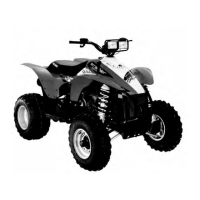
